 |
February 2013
|
February 2013 // Volume 51 // Number 1 // Research In Brief // v51-1rb3
"Let's Talk": Collaboration Between Family and Consumer Sciences Extension Personnel and Teachers
Abstract
Interactive meetings between New Mexico Family and Consumer Sciences (FCS) teachers and Extension personnel (county Home Economics agents and state FCS specialists) were conducted to promote collaboration between the two parties. Based on pre- and post-meeting surveys, both parties showed similarities in almost all perceptions and expectations concerning collaboration. Teachers expressed significantly stronger wishes for collaborations on presentations and service projects and in the areas of Food Technology and Clothing, Fashion and Textiles in the pre-survey. Significant differences were not evident in the post-survey, indicating the contribution of the meetings in bringing these groups together on attitudes towards collaboration.
Introduction
In February and May 2010, the Department of Family and Consumer Sciences (FCS) at New Mexico State University (NMSU) conducted meetings designed to foster collaboration between FCS teachers and Extension personnel (county Home Economics agents and state FCS specialists) in Albuquerque and Las Cruces, the two most populated areas in New Mexico (NM). New Mexico, the fifth largest state, is a rural, sparsely populated state. The idea for these meetings came from the Advisory Committee of the FCS and Extension Home Economics Departments at NMSU, whose members sensed a lack of collaboration between FCS teachers and Extension personnel. Collaboration is a highly relevant topic in today's society for professionals in which resources of all types are limited and appear to be shrinking.
A search of literature found no studies concerning collaboration between Extension Agents and FCS teachers. Studies about collaborations between teachers and Extension personnel have actually been done in areas such as agricultural education (Hillison, 1996), forestry (Broussard & Jones, 2001), and livestock (Grage, Place, & Ricketts, 2004). The main underlying reasons noted for fostering collaboration in these studies are similar. Both parties share a goal of educating their constituents. At times, they directly serve the same audiences (e.g., 4-H projects). Since the extent of collaboration between FCS teachers and Extension personnel has not been ascertained, a plan was developed and implemented to determine the existing degree of collaboration and to develop strategies to foster collaboration between the two groups. The program was titled, "Let's Talk: Collaboration between Family and Consumer Sciences Teachers and County Agents."
The objectives of this article are to explain the development of the survey instruments and format of the interactive collaboration meetings designed to create and foster collaboration between FCS teachers and Extension personnel. In addition, differences in perceptions and opinions regarding collaboration and potential areas for future collaboration are reported based on the survey results.
Methods
Participants
Invitations to the meetings were mailed to all FCS teachers and Cooperative Extension Service (CES) Home Economics Agents in the five counties surrounding the two major population areas. The total population (165) was invited because all could be accommodated with available resources. State Extension specialists and university administrators were also invited. In addition, invitations were distributed statewide through a professional organization listserv in an attempt to invite all interested parties from rural and urban areas.
Twenty-three participants, including the four project coordinators, attended the first meeting, and 27 attended the second meeting. Participants in these pilot meetings included Associate Deans from the College of Agricultural, Consumer and Environmental Sciences at NMSU; a CES department head; CES specialists from NMSU; CES Home Economics Agents; Advisory Council members; FCS teachers; the Graduation, Reality, and Dual Skills Director for New Mexico; a representative from the New Mexico Association of Family and Consumer Sciences (NMAFCS); a NMSU Hotel, Restaurant and Tourism Management (HRTM) representative; and the project coordinators.
The meeting attendance by location, invitation, and job title is presented in Table 1. The attendance rate in the two locations combined was 30.3% (50 attended out of 165 invited). Although only 18 out of 75 (24%) invited schools were represented, most of the larger high schools in the state were represented at the collaboration meetings.
| Meeting Site | Las Cruces | Albuquerque | ||
| Counties Involved | Doña Ana, Otero | Bernalillo, Valencia, Sandoval | ||
| Invited | Attended | Invited | Attended | |
| Teachers | 48 | 11 | 62 | 13 |
| College Administrators | 4 | 2 | 4 | 1 |
| Extension Specialists | 5 | 3 | 5 | 2 |
| County Extension Agents | 2 | 1 | 15 | 5 |
| Advisory Council Members | 10 | 3 | 10 | 1 |
| Project Coordinators | - | 3* | - | 3* |
| Other | 2 | |||
| Total | 23 | 27 | ||
|
* Fourth project coordinator was counted as an Extension specialist |
||||
Procedure
The half-day meetings were held at county Extension offices in the two major population areas of the state and included FCS teachers and CES Home Economics Agents who were initially invited by mail, with follow-ups by emails to non-responders. Both interactive meetings were conducted on Saturday mornings in Spring 2010 to enable people to easily attend. Summer and holiday breaks were avoided because people tend to be unavailable.
The first meeting was held on February 27, 2010, at the Doña Ana County Extension Office in Las Cruces, and the second meeting was held on Saturday, May 1, 2010, at the Bernalillo County Extension Office in Albuquerque. Each meeting was planned to run from 9 a.m. until 12:30 p.m.
As the participants arrived, they began to network over coffee and refreshments. Lunch was available at the end of the meetings while participants concluded their time together. Although some of the participants knew each other, many were meeting for the first time, and contacts and information exchanged freely.
The agenda included introductions, followed by short talks by NMSU College of Agricultural, Consumer and Environmental Sciences (ACES) administrators, and/or the NMSU Extension Director (or an Associate). CES agents and specialists presented their programs and resources available to the FCS teachers. Each FCS teacher provided an overview of her program content strengths and resources. Finally, teachers gathered around their respective county Extension agents to further discuss collaboration opportunities and ways to work together and share resources.
A pre-survey was administered around 9 a.m. along with refreshments, while a post-survey was done at the around noon, just before lunch was served. The agenda of the half-day program is included in the Appendix.
Instruments
For the study, two surveys were created. The pre-survey resembled the post-survey, except that questions on current activity and subject matter were asked only in the pre-survey.
The survey instrument summary is provided in Table 2. The items of the survey inquired about opinions regarding collaboration efforts, current collaboration activities and content areas, wishes for future collaborations for activities and content areas, factors affecting levels of collaboration, expectations for future collaboration efforts, and an open-ended section for additional feedback.
| Part | Response Format and Survey Items | Pre | Post |
| I. Indicate your opinion on each of the following statements by checking the appropriate column. |
Five-point Likert scale: Strongly Agree, Agree, Neutral, Disagree, and Strongly Disagree (1) County agents are very important to FCS teachers, (2) Current collaboration efforts between FCS teachers and county agents are at an ideal level, (3) Current collaboration efforts need to be increased, (4) FCS teachers need to increase county agent involvement in schools and school projects, (5) County agents need to increase FCS teacher involvement in Extension programming, (6) County agents can significantly add value to FCS teacher effectiveness, (7) FCS teachers can significantly add value to county agent effectiveness, (8) County agents and FCS teachers should cooperate on a regular basis |
X | X |
| II. For each activity below, indicate the level of FCS teacher and county agent collaboration that currently exists for that activity in your setting. |
Five-point Likert scale: Almost Always, Usually, Sometimes, Rarely, and Almost Never (1) Presentations, (2) County Fairs, (3) Service Projects, (4) 4-H Events, (5) Family, Career, and Community Leaders of America (FCCLA) Events, (6) Professional Trainings, (7) Subject Matter Content Sharing, (8) Material Resource Sharing, (9) Newsletter Articles, (10) Other |
X | |
| III. For each of the activities listed below, check activities in which you wish there was more collaboration between FCS teachers and county agents in your situation. |
Check-box format (1) Presentations, (2) County Fairs, (3) Service Projects, (4) 4-H Events, (5) FCCLA Events, (6) Professional Trainings, (7) Subject Matter Content Sharing, (8) Material Resource Sharing, (9) Newsletter Articles, (10) Other |
X | X |
| IV. For each of the subject matter content areas listed, indicate the current level of collaboration between FCS teachers and county agents in your situation. |
Five-point Likert scale: Almost Always, Usually, Sometimes, Rarely, and Almost Never (1) Health and Wellness, (2) Food and Nutrition, (3) Food Technology, (4) Family Relationships, (5) Child Development, (6) Family Resource Management, (7) Disaster Preparedness, (8) Clothing, Fashion, and Textiles, (9) Housing and Design, (10) Other |
X | |
| V. For each of the subject matter content areas listed below, check areas in which you wish there was more collaboration between FCS teachers and county agents in your situation. |
Check-box format (1) Health and Wellness; (2) Food and Nutrition; (3) Food Technology; (4) Family Relationships; (5) Child Development; (6) Family Resource Management; (7) Disaster Preparedness; (8) Clothing, Fashion, and Textiles; (9) Housing and Design; (10) Other |
X | X |
| VI. Check each factor below that impacts the level of collaboration between FCS teachers and county agents in your situation. Check all that apply. |
Check-box format Select all that apply for 22 statements. Examples include: "We have similar areas of interest", "We have dissimilar areas of interest", "I need the expertise offered", "I do not need the expertise offered", "Collaboration enhances my perceived competency", and "Collaboration does enhance my perceived competency." |
X | X |
| VII. What level of change do you expect in FCS teacher - county agent collaboration efforts in your situation in the near future (about six months)? | Five-point Likert scale: Significant Increase, Moderate Increase, No Change, Moderate Decrease, and Significant Decrease | X | X |
| VIII. Additional feedback. Please share any additional comments on collaboration efforts. | Open-ended Responses | X | X |
Statistical Methods
For comparing results between FCS teachers and Extension personnel (county agents and specialists), the researchers used different procedures depending on the nature of the responses and data. For the five-point Likert-scale items, the researchers utilized chi-square. However, when a cell size was less than five observations, the researchers had to resort to the Fisher exact t-test, which does not come with a "test statistic" (Rosner, 2010). In SAS, PROQ FREQ with FISHER option was utilized. Regular chi-square tests were performed under the assumption of all expected cell values of at least five (Rosner, 2010). For "select any that apply" items, the researchers opted for McNemar's test to test for differences in percentages between two groups. The significance level was set at p≤0.05.
Results
Teacher-Extension Response Comparisons
Twenty-four FCS teachers and eight Extension personnel completed both the pre- and post-surveys, for a response rate of 97.0% (32 out of 33). Project coordinators, administrators, and advisory board members were not asked to complete the surveys. Extension personnel included county Home Economics Agents and NMSU state-level Extension specialists, because teachers and state specialists may work together without county agent participation.
From a total of 67 items in the pre-survey and 49 items in the post-survey, responses on five items were significantly different between teachers and Extension personnel in the pre-survey. One response showed a significant difference in the post-survey. Data are provided in Table 3.
| Question Item | Pre-Survey | Post-Survey |
| Section I. Opinion | ||
| Section II. Current Collaboration Activities | N/A* | |
| Section III. Future Collaboration Activity Wishes | ||
| Presentation | 0.0056 | |
| Service Projects | 0.0316 | |
| Section IV. Current Collaboration Subject Area | N/A* | |
| Section V. Future Collaboration Program Area Wish | ||
| Food Technology | 0.0099 | |
| Clothing, Fashion, and Textiles | 0.0302 | |
| Section VI. Factors Impacting Collaboration | ||
| I need the expertise offered | 0.0120 | 0.0228 |
|
*"N/A" (not applicable): Not part of the post-survey |
||
The researchers examined each significant item and the percentages of teachers and Extension personnel based on pre- and post-survey responses. Graphic representations of these differences at the pre- and post-survey times are shared in Figure 1. The graphics focus on the response trends of FCS teachers and Extension personnel at these points of time. In each figure, an asterisk (*) placed next to the "Pre" and/or "Post" label indicates significance (p≤0.05).
Figure 1.
Pre- and Post-Meeting Comparisons for Results with Significant Differences
(T = FCS Teachers and E = Extension Personnel)
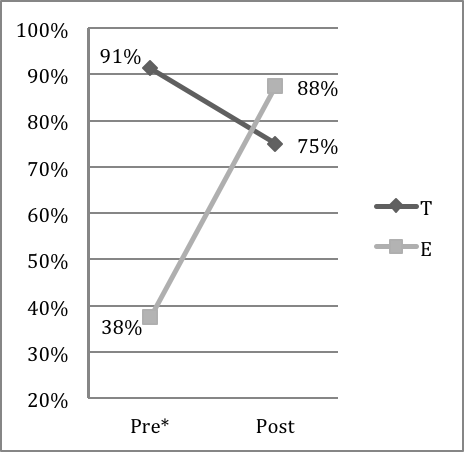
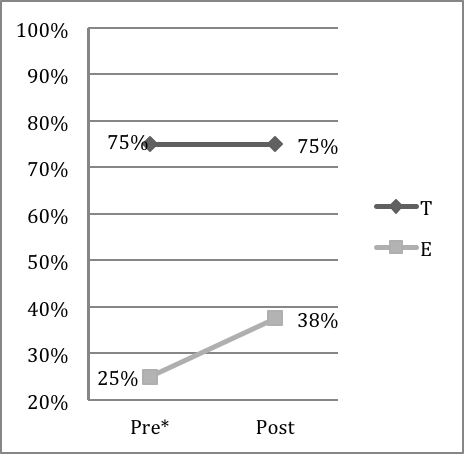
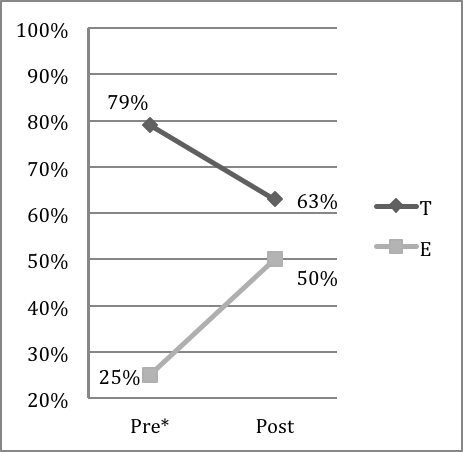
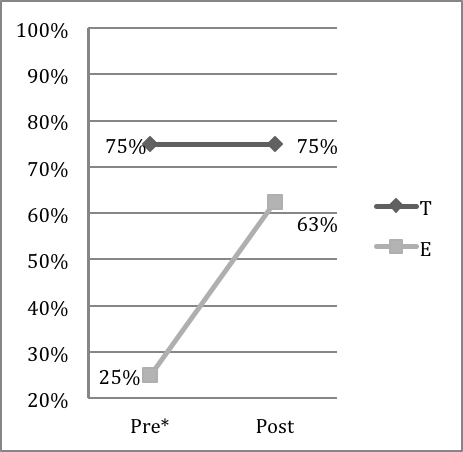
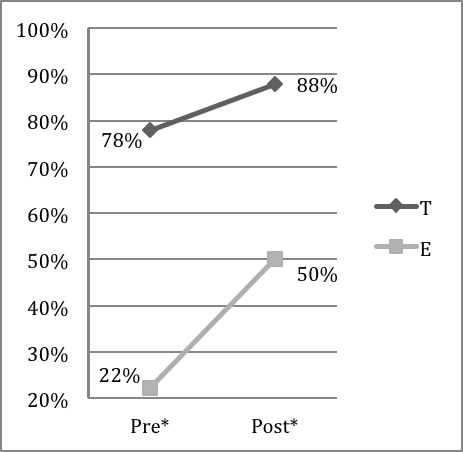
The five significant differences between FCS teachers and Extension personnel in the pre-survey are summarized as follows.
- 91% of FCS teachers checked "presentations" as an activity in which respondents had wished there was more collaboration, compared to 38% of Extension personnel;
- 75% of teachers checked "service projects" as an activity in which respondents had wished there was more collaboration, compared to 25% of Extension personnel;
- 79% of teachers selected Food Technology as a program area in which respondents had wished there was more collaboration, compared to 25% of Extension personnel;
- 75% of teachers selected Clothing, Fashion, and Textiles as a program area in which respondents had wished there was more collaboration, compared to 25% of Extension personnel; and
- 78% of teachers responded "I need the expertise offered" as a factor impacting collaboration, compared to 22% of Extension personnel.
The sole difference in the post-survey was also significantly different in the pre-survey:
- 88% of teachers responded "I need the expertise offered" as a factor impacting collaboration, compared to 50% of Extension personnel.
Despite its significance in both the pre- and post-surveys, the percentage response gap between the two groups became smaller in the post-survey, as evident in Figure 1 (e).
Areas for Future Collaboration
Based on the post-survey, the activities and content areas in which both parties had wished for more collaboration are presented in Table 4. The top three activities were professional training, material resource sharing, and presentations. More than 70% of respondents wished for more future collaboration in Food and Nutrition, Family Resource Management, Family Relationships, Health and Wellness, Child Development, and Clothing, Fashion and Textiles.
Table 4.
Activities and Content Areas Where Future Collaboration Is Desired
Post-Survey Numbers (n=32)
| Activities | n | % |
|
Professional Trainings |
27 |
84.4 |
|
Material Resource Sharing1 |
26 |
81.3 |
|
Presentations |
25 |
78.2 |
|
Subject Matter Content Sharing |
23 |
71.9 |
|
Service Projects |
21 |
65.6 |
|
Newsletter Articles |
19 |
59.4 |
|
4-H Events |
16 |
50.0 |
|
County Fairs2 |
16 |
50.0 |
|
FCCLA Events |
15 |
46.9 |
|
1 E.g., media kits, DVD 2 E.g., judging, exhibits |
||
|
Content Areas |
n |
% |
|
Food and Nutrition |
26 |
81.3 |
|
Family Resource Management3 |
26 |
81.3 |
|
Family Relationships |
25 |
78.2 |
|
Health and Wellness |
24 |
75.0 |
|
Child Development |
24 |
75.0 |
|
Clothing, Fashion, and Textiles |
23 |
71.9 |
|
Food Technology |
19 |
59.4 |
|
Housing and Design |
19 |
59.4 |
|
Disaster Preparedness |
17 |
53.1 |
|
3 E.g., time, energy, money |
||
Discussion and Implications
Given the opportunity to discuss possible areas for collaboration, both FCS teachers and Extension agents found common ground through ways that could be mutually beneficial. A set of pre- and post-surveys on collaboration between NM FCS teachers and Extension personnel showed that these two groups of professionals had remarkable similarities in opinions, perceptions, and expectations concerning collaboration. These results were similar to a previous study done in the agriculture area (Ricketts & Bruce, 2009). Out of the five differences observed in the pre-survey before the FCS teachers and Extension personnel had opportunities to share and collaborate, only one difference remained significant in the post-survey.
The bulk of the differences arose in the activities and program areas wished for future collaboration. Compared to Extension personnel, FCS teachers showed stronger wishes for collaborations on presentations and service projects and in the areas of Food Technology and Clothing, Fashion, and Textiles, as indicated in the pre-survey.
These four differences were no longer observed in the post-survey after FCS teachers and Extension personnel participated in the dialogue sessions. These convergence trends, as illustrated in Figures 1 (a) through (d), point to the contribution of the collaboration meetings in bringing together these two groups. The convergence trend was also observed for "I need the expertise offered" factor (Figure 1 (e)), which was significant in both the pre- and post-surveys.
Recognizing the value of collaboration may promote efforts between the two groups to share resources and expertise. Activities that were in high demand tended to be those directly related to teaching (e.g., professional training, material resource sharing, and presentations). Content areas on which collaboration was requested can be divided into two tiers based on their response frequency. The content areas in higher demand were Food and Nutrition; Family Resource Management; Family Relations; Health and Wellness; Child Development; and Clothing, Fashion, and Textiles. The content areas in lower demand were Food Technology; Housing and Design; and Disaster Preparedness. These results, however, should be taken cautiously because in the end, collaboration efforts between teachers and Extension personnel depend on the capabilities to match both parties' demand and supply of resources in a manageable geographical area, typically the county level.
The implications for Extension and FCS teachers are evident. Extension administrators, specialists, and agents should lead and support efforts to increase and promote collaborations between Extension and FCS teachers. Extension should consider broadening its audience for programs to include training programs for FCS teachers. Content area specialists in Food and Nutrition; Family Resource Management; Family Relations; Health and Wellness; Child Development; and Clothing, Fashion, and Textiles areas should provide the most recent research-based information to the county agents to share with the FCS teachers. Specialists may want to look for opportunities to target both county agents and teachers as they dispense their information. School administrators, school district vocational directors, and Extension personnel need to encourage FCS teachers to connect with county Extension agents to acquire the most current research-based knowledge and skills, and provide Extension personnel with the opportunity to utilize the teachers' skills and expertise.
The researchers suggest the format used in the interactive meeting in this study may be helpful to foster collaboration between these two groups; however, participants in the meetings wished for more time to collaborate (Bartley, Abdul-Rahman, Cummings, & O'Brien, 2011). Such meetings might be held in school settings as well as county Extension offices. Because lack of time was a factor in meetings conducted in the study, future meetings might be longer and held more frequently to allow for continuity in planning and implementation of collaboration efforts. Academic faculty at land-grant universities also need to support collaboration efforts by providing their expertise for professional training, material resource sharing, and presentation content and strategies. Land-grant universities could sponsor collaboration workshops, meeting, and seminars for Extension personnel and FCS teachers. FCS teachers and Extension agents need to be encouraged and provided funding by their administrators to attend each other's professional meetings to develop areas for collaboration.
Additional research is needed on collaboration efforts between Extension personnel and teachers in various content areas. Issues that need to be explored are the degree of collaboration that currently exists across the United States, the benefits of collaboration, the differences in collaboration that exist in urban and rural settings, and factors affecting the levels of collaboration. Longitudinal studies need to track the actual collaboration that results from Extension efforts to increase collaboration with teachers.
In the study reported here, the meetings to foster collaboration brought FCS teachers and Extension personnel together to share their programs and successes, inform each other about resources available, and strategize for collaboration efforts. Discussions at the regional level focused on FCS school program updates, county FCS Extension programs, and state FCS specialists' areas of emphasis. The meetings improved dialogue between FCS teachers and Extension personnel at the regional and county levels and emphasized the contributions, expertise, and resources each can make to the others' programs.
References
Bartley, S. J., Abdul-Rahman, M. F., Cummings, M. N., & O'Brien, D. (2011). Fostering collaboration: FCS teachers and Cooperative Extension faculty. Journal of Family and Consumer Sciences, 103(30), 43-44.
Broussard, S. R., & Jones, S. B. (2001). Extension, communities, and schools: Results of a collaborative forestry education project in Philadelphia. Journal of Extension [On-line], 39(3) Article 3FEA5. Available at: http://www.joe.org/joe/2001june/a5.php
Grage, K. D., Place, N. T., & Ricketts, J. C. (2004). Exploring cooperation between secondary agricultural educators and livestock extension agents: A case study. Journal of Extension [On-line], 42(6) Article 6RIB7. Available at: http://www.joe.org/joe/2004december/rb7.php
Hillison, J. (1996) Agricultural education and cooperative extension: The early agreements. Journal of Agricultural Education, 37(1), p9-14.
Ricketts, K. G., & Bruce, J. A. (2009). "Co-opetition?" Can it exist between extension and agricultural education?—A study on interdisciplinary cooperation. Journal of Extension [On-line], 47(5) Article 5RIB1. Available at: http://www.joe.org/joe/2009october/rb1.php
Rosner, B. (2010). Fundamentals of biostatistics (7th ed.). Cambridge, MA: Duxbury Press.
Appendix: Meeting Program
Let's Talk:
Collaboration between Family and Consumer Sciences
Teachers and County Agents
Sample Meeting Agenda
| 9:00-9:30 a.m. | Coffee and Pastry, Visiting, and Survey |
| 9:30-9:45 a.m. | Introductions |
| 9:45-10:30 a.m. | Sharing by Extension Personnel
|
| 10:30-11.15 a.m. | Sharing by FCS Teachers |
| 11:15-11:45 a.m. |
Dialogue on Plans for Collaboration Summary and Plans for Future |
| 11:30 a.m. | Completion of Survey and Evaluation Survey |
| 11:45 a.m. | Lunch (boxed sandwiches and dessert) and continued dialogue |
| 12:30 p.m. | Adjournment |




